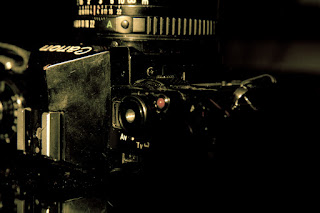 Canon's A-1 semi-professional camera is a solid, robust, and weighty Advanced Amateur/Semi-Professional entry into the camera world. With shutters speeds from 30s to 1/1000s it out distances itself from the AE-1, and AE-1P (which has the same metering system).
Canon's A-1 semi-professional camera is a solid, robust, and weighty Advanced Amateur/Semi-Professional entry into the camera world. With shutters speeds from 30s to 1/1000s it out distances itself from the AE-1, and AE-1P (which has the same metering system). The body is only available in Black, so don't expect to see any silver or brushed aluminum cladding on this camera.
The camera has a presence to it. The shape, the design, and especially the solid black body with the white accents of the lettering. When paired up with the Motordrive MA, it makes quite the site to behold. A Canon Speedlite 199a, Motordrive MA, and 50mm ƒ/1.4 (or 85mm ƒ/1.8 or even the ƒ/1.2) is just an amazing site to see.
 Some of the weirder aspects to this camera is the ASA dial. With speeds from ASA6 to ASA12800, it seems a bit extreme. I do not know of any film that was ever up to ASA12800, and would hate to see the grain in 35mm for a film that fast.
Some of the weirder aspects to this camera is the ASA dial. With speeds from ASA6 to ASA12800, it seems a bit extreme. I do not know of any film that was ever up to ASA12800, and would hate to see the grain in 35mm for a film that fast.It's also a bit tricky to adjust. There's a little metal lever on the side of the dial to help lock it so you can't accidentally turn it from one ASA to another mid-roll. This lever is a pain to work with because it is in a very difficult to access location.
There's also an exposure compensation dial on the ASA dial, with a lock button located at the rear top of the camera beside the Pentaprism hump, and located almost directly in front of the film-plane mark.
There is also a switch that turns the red LEDs inside the viewfinder on and off.
Also located on the Pentaprism hump, on the back of the camera, is a switch to black out the viewfinder to prevent fogging of the film during long exposures.
In the middle of the ASA dial is the rewind crank which also doubles as a level to pop open the back of the camera, or the film-chamber door.
Opposite side we have the On(A)/Off(L) and self timer (2/10) switch which, does exactly what you'd expect. Turns the camera on, or off, or sets the exposure timer.
There is also the switch to adjust from Av (aperture Priority) to Tv (Shutter Priority) along with a switch to guard against accidentally changing the settings.
Depending on what setting you have the camera set to, you will see a window because the Av/Tv switch that has shutter speeds, or Aperture values depending on the priority mode you have the camera set to.
Looking on the left side of the camera at the front you a few more buttons and a slider switch. The slider is the DOF preview switch, which stops down the lens, which is good if you are using an older FL lens which requires stop down metering.
Above that switch is a Meter preview button, which will display the settings the camera's meter reads according to the preset shutter speed or aperture value.
Above that button, there is third button, which is nothing more than the exposure compensation button. As on the AE-1 and AE-1P, it'll open the lens 2 full stops, which is very useful when metering for backlit scenes.
On the right side of the camera is the battery door. When opened it houses a PX28 battery, or 4 LR44 batteries in sequence.
Once the film is used, it is then rewound back into the canister using the film rewind crank. But before you can rewind the film, you have to press a button which is located on the bottom of the camera.
Although I've yet to finish a roll of film in this camera, the half-dozen photos I have already taken with it, I already know I'm going to have a hard time putting this camera down.
Until next time, keep those shutters firing!

















































